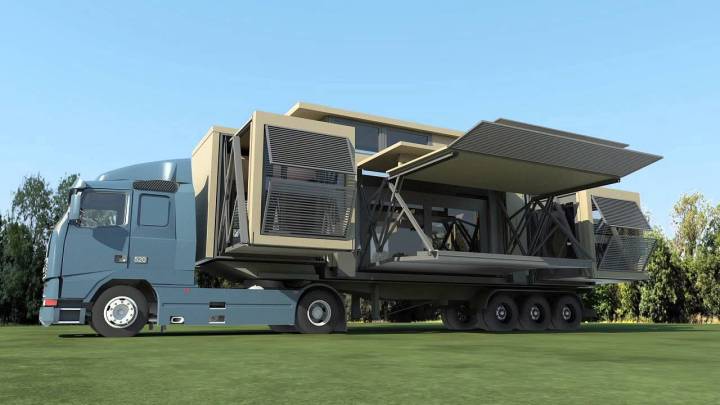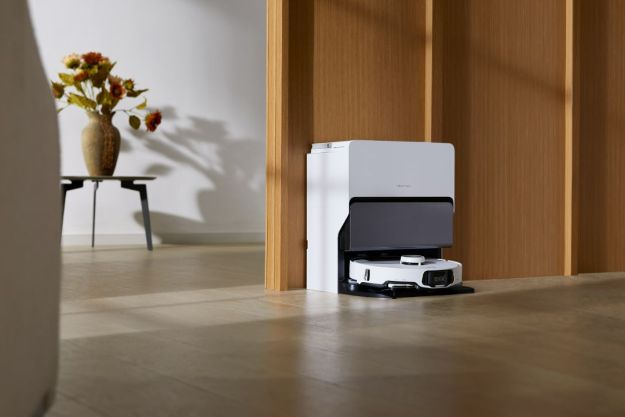
The key to their cool new offering is a patented lever system that controls counter-balanced folding linkages. This system allows the structure or home to effectively ‘make itself’— all the owner has to do is push a button and watch it unfold. Then they simply secure it using an electric drill. The unit closes by being pulled in with a winch, which has a fail-safe. In fact, the unit does not close until the floors are folded up. The company even promises on its website, “No, it will NOT squash you.”
Company officials say there’s even room to store some furniture inside the compacted structure. Once set up, the building unfolds to three times its original transport size, with all internal fixtures and fittings pre-installed. The company’s base unit, the U-Box, is approximately 645 square feet when unfolded.
“We wanted to do something new, but at the same time, we wanted to challenge people to think differently about structures,” founder David Martyn told Forbes. “We live in houses that are stuck in the ground. We aren’t a nomadic culture anymore, so this is a new concept based on a modern interpretation of nomadism as it relates to the global economy.”
Ten Fold is heavily invested in how these products can be used. While affordable housing comes to mind, the Ten Fold team also envisions other uses. For example, a school room could be moved from site to site depending on need. Affordable single-family homes could be airdropped into Africa. The same goes for mobile medical clinics, refugee camps, and other educational facilities.
The technology is so versatile that a single truck-sized box could alternatively be used to construct a 100 M2 off-grid building, a 200-seat covered grandstand, or a 100-kw solar array. The company has been reaching out to architects, engineers and manufacturers to explore new ways of deploying their buildings.
This concept could change the construction sector in many ways. First, because the structure can be unfolded anywhere and not just on a build site, it eliminates the need for foundations, builders and construction vehicles and materials. Because they can be delivered anywhere by truck or air, they could re-purpose land that might otherwise remain underutilized. Lastly, those who get antsy living in one place for too long could simply pick up and move elsewhere. The structures can be refolded and moved to a new location in minutes rather than days and can be interlinked or stacked in various combinations to expand functionality.
“This is about speed, size and ease, and there’s nothing else that does it.”
Martyn is an architect with more than 25 years of experience designing homes, office buildings and other structures throughout the U.K. He was inspired to design Ten Fold products because his four adult children pay painfully-steep rents in the UK, where the average rent for a one-bedroom flat in London is around $1,600 per month.
“It will allow the young to get a building without owning the land,” Martyn recently told The Sun. “It changes the dynamics of the market, which does need to change because it is a transportable property asset. This is a real solid building that doesn’t have to stay in the same place. This is about speed, size and ease, and there’s nothing else that does it.”
From a design perspective, Martyn also wanted the units to be independent of postmodern technology.

“Think Victorian engineering,” Martyn recently explained. “Ten Fold structures don’t have computers or networking; they are simply using physics. Everyone is always thinking that they have to be more automated, but in fact this is more automatic by being less automated.”
The concept and the company’s prototype videos have attracted a massive viral audience as well as interest from the housing, retail, events, mining and energy sectors. The technology has also attracted attention from people who want to live off the grid. Ten Fold says the structures can be outfitted for off-the-grid living, depending on the climate and the degree of autonomy required. While the units are perfectly capable of attaching to a national electric grid, they can also be outfitted with solar panels, generators, and other alternative solutions.
The company was founded in 2011 with around four million pounds in private funding. The company’s first “real world” project is with G3Festivals, a Dutch company that specializes in festival accommodations and infrastructure.
The units are reasonably priced compared to traditional housing, with an estimated cost starting at about $130,000. It’s unclear when models will be made available to the general public. Rather than acting as a traditional manufacturer, Ten Fold is licensing out its patented technology to contractors. That way, local manufacturers can build the products and Ten Fold doesn’t have to ship units around the world.
On its website, Ten Fold confirms that the European standard production drawings are complete and are being converted to American building codes. The company hopes to begin product deliveries by the end of 2018; possibly sooner for the American and mainland European markets.
Ten Fold’s breakthroughs are just one entry in a global race to change the construction industry. From movable walls, Zurich’s robot-built house, shipping container homes, and modular hotel construction, the face of the building industry could look very different not so far in the future.


